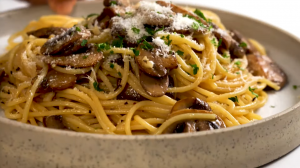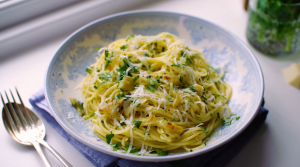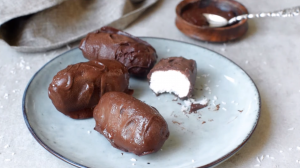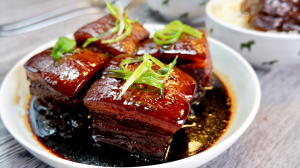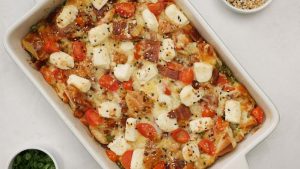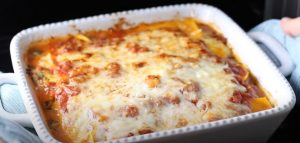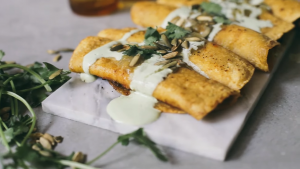This recipe for eggplant and fried capers spaghettini is a delightful fusion of Sicilian flavors. The dish balances the creaminess of eggplant, the crispiness of fried capers, the sweetness of pecorino cheese, and the al dente texture of spaghettini to create a rich, savory meal that leaves a lasting impression.
Photos of Eggplant and Fried Capers Spaghettini Recipe
This recipe requires capers, an ingredient which you may not commonly find in your pantry. Capers are small flower buds that have been pickled and are known for their tangy, briny flavor. They're often used in Mediterranean cuisines, particularly Italian recipes. You might find them in the pickle aisle of your local supermarket. Another ingredient to note is young pecorino, a type of Italian cheese made from sheep's milk. It's a hard cheese, similar to Parmesan, but has a unique, somewhat tangy flavor.
Ingredients for Eggplant and Fried Capers Spaghettini
Salted capers: These are pickled flower buds that add a tangy, saltiness to the dish.
Spaghettini: A thinner version of spaghetti, it's perfect for soaking up the flavors of the dish.
Extra virgin olive oil: Used for frying and flavoring the dish.
Eggplant: It adds a meaty texture and absorbs the flavors of the dish.
Salt and freshly ground pepper: Basic seasonings used to enhance the flavors.
Garlic: Adds a punch of flavor to the dish.
Red pepper: Adds a spicy kick to the dish.
Crustless Italian bread: Used to make the croutons for added crunch.
Young pecorino: A hard Italian cheese made from sheep’s milk, it adds a tangy, salty flavor to the dish.
One reader, Britney Decker says:





This eggplant and fried capers spaghettini recipe is a game-changer! The combination of flavors is incredible. The crispy capers and tender eggplant create a perfect balance. The dish is bursting with savory goodness. It's a must-try for anyone who loves a unique and delicious pasta dish.
Cooking Techniques for Eggplant and Fried Capers Spaghettini Recipe
How to fry capers: Rinse the capers to remove excess salt, then pat them dry. Heat oil in a skillet and add the capers, frying them until they are golden and puffed, about 2 minutes. Use a slotted spoon to transfer the capers to a paper towel-lined plate to drain.
How to make garlic croutons: Heat olive oil in a skillet, then add whole garlic cloves and diced bread. Fry the mixture, stirring, until the croutons are golden, about 2 minutes. Use a slotted spoon to transfer the croutons to a paper towel-lined plate to drain.
How to cook spaghettini al dente: In a large pot of salted boiling water, cook the spaghettini until it is just al dente, following the package instructions. This usually takes about 8-10 minutes. Once cooked, drain the pasta well, reserving some of the cooking water for later use.
How to season eggplant: Cut the eggplant into small cubes or slices, then season lightly with salt and pepper before cooking. This will help to enhance the flavor of the eggplant as it cooks.
How to simmer pasta with reserved cooking water: After adding the pasta to the eggplant, incorporate the reserved cooking water and pecorino. Simmer the mixture, tossing gently, until the water is nearly absorbed, about 2 minutes. This step helps to create a creamy and flavorful sauce for the pasta.
How To Make Eggplant and Fried Capers Spaghettini
Whip a light but flavor-packed lunch meal with this spaghettini recipe! It’s a pasta dish tossed with crispy capers and tender eggplant for a tasteful meal.
Serves:
Ingredients
- ¼cupcapers,salted
- 12ozspaghettini
- ¾cupextra virgin olive oil
- 1large eggplant
- salt and freshly ground pepper
- 3garlic clove
- pinchcrushed red pepper,(large pinch)
- 1cupItalian bread,crustless, ⅓ inch diced
- ¼;
Instructions
-
In a large cup, soak the salted capers in plenty of cold water for 15 minutes. Drain the capers and squeeze dry.
-
In a large pot of salted boiling water, cook the spaghettini until just al dente. Drain the pasta well, reserving ¾ cup of the cooking water.
-
In a large, deep nonstick skillet, heat ¼ cup of the oil until shimmering. Add the eggplant, season lightly with salt and pepper and cook over high heat, for about 6 minutes, stirring occasionally, until tender.
-
Add the sliced garlic and crushed red pepper and cook for about 2 minutes until the garlic is softened.
-
In a small skillet, heat the remaining ½ cup of oil until shimmering. Add the capers and fry over high heat, shaking the pan slightly, for for 2 minutes, until the capers are golden and puffed. Using a slotted spoon, transfer the capers to a paper towel-lined plate.
-
Add the whole garlic clove and the diced bread to the oil and fry for about 2 minutes, stirring, until golden.
-
Using a slotted spoon, transfer the croutons to the plate. Discard the garlic clove
-
Add the pasta to the eggplant. Add the pecorino and the reserved cooking water and simmer, tossing, for about 2 minutes, just until the water is nearly absorbed.
-
Serve the pasta in shallow bowls, sprinkled with the fried capers and croutons. Enjoy!
Nutrition
- Calories: 779.78kcal
- Fat: 44.74g
- Saturated Fat: 7.41g
- Monounsaturated Fat: 30.45g
- Polyunsaturated Fat: 5.08g
- Carbohydrates: 80.04g
- Fiber: 8.66g
- Sugar: 8.51g
- Protein: 16.61g
- Cholesterol: 8.58mg
- Sodium: 757.23mg
- Calcium: 140.34mg
- Potassium: 624.43mg
- Iron: 2.33mg
- Vitamin A: 10.50µg
- Vitamin C: 4.84mg
-
Pro Tip for Perfecting Eggplant and Fried Capers Spaghettini
When frying your capers, ensure that the oil is hot enough before adding them in. This will ensure that they become golden and puffed, giving them a delightful crunch. However, be careful not to overheat the oil as this could cause the capers to burn. A good way to test the oil is by dropping a single caper in. If it sizzles immediately, the oil is ready.
Time-Saving Tips for Preparing This Spaghettini Dish
Prep ahead: Chop and prepare all the ingredients in advance to streamline the cooking process.
Multitask: While the pasta is cooking, start preparing the eggplant and capers to save time.
Efficient cooking: Use multiple burners on the stove to cook different components simultaneously.
Organized workspace: Keep all the necessary ingredients and tools within reach to avoid wasting time searching for items.
Quick cleanup: Clean as you go to minimize the post-cooking cleanup time.
Use kitchen gadgets: Utilize kitchen tools like a food processor or mandoline to speed up the prep work.
Follow the recipe: Read through the entire recipe before starting to ensure a smooth and efficient cooking process.
Delegate tasks: If cooking with others, divide the tasks to work together and save time.
Substitute Ingredients For Eggplant and Fried Capers Spaghettini Recipe
spaghettini - Substitute with linguine: Linguine is a suitable substitute for spaghettini as it has a similar thin and long shape, making it ideal for this recipe.
extra virgin olive oil - Substitute with avocado oil: Avocado oil has a mild flavor and high smoke point, making it a great alternative for extra virgin olive oil in this recipe.
eggplant - Substitute with zucchini: Zucchini can be used as a substitute for eggplant, providing a similar texture and mild flavor that complements the other ingredients in the dish.
salted capers - Substitute with green olives: Green olives can be used as a substitute for capers, providing a briny and salty flavor that complements the dish.
large red pepper - Substitute with yellow bell pepper: Yellow bell pepper can be used as a substitute for red pepper, offering a slightly sweeter flavor and vibrant color to the dish.
young pecorino - Substitute with parmesan: Parmesan cheese can be used as a substitute for young pecorino, providing a similar nutty and salty flavor to enhance the dish.
Plating Ideas for Eggplant and Fried Capers Spaghettini
Elevate the dish with a stunning plating: As culinary professionals with three Michelin stars, presentation is key. Arrange the spaghettini and eggplant in a visually appealing manner on the plate, ensuring each element is showcased beautifully.
Incorporate contrasting textures: Introduce a variety of textures to the dish, such as the tender eggplant, al dente spaghettini, and crispy fried capers and croutons, to create a multi-dimensional dining experience.
Highlight the vibrant colors: The rich purple of the eggplant, the golden hue of the fried capers and croutons, and the red pepper add visual appeal to the dish. Ensure the colors are balanced and visually striking on the plate.
Utilize elegant serving dishes: Select elegant and sophisticated serving dishes that complement the upscale nature of the dish. This attention to detail will enhance the overall dining experience.
Garnish with fresh herbs: Sprinkle the dish with freshly chopped parsley or basil to add a pop of color and a touch of freshness to the presentation.
Create a focal point: Arrange the components of the dish to create a focal point on the plate, drawing attention to the star ingredients and showcasing the artistry of the dish.
Use negative space: Embrace negative space on the plate to allow the dish to breathe and to emphasize the beauty of the individual elements.
Consider the plate shape and size: Choose the appropriate plate shape and size to complement the dish, ensuring that it enhances the visual appeal and allows the components to shine.
Add a finishing drizzle of high-quality olive oil: Just before serving, drizzle a small amount of extra virgin olive oil over the dish to add a luxurious sheen and a final touch of flavor.
Serve with precision and finesse: When presenting the dish, demonstrate precision and finesse in the plating process, showcasing the attention to detail and culinary expertise.
Essential Kitchen Tools for Making Spaghettini with Eggplant and Capers
Food processor: A food processor is a versatile kitchen appliance that can be used for various tasks such as chopping, pureeing, and blending ingredients.
Mixing bowl: A mixing bowl is an essential kitchen tool used for combining ingredients, mixing batters, and preparing various recipes.
Chef's knife: A chef's knife is a multi-purpose kitchen tool used for slicing, dicing, and chopping a wide variety of ingredients.
Colander: A colander is a bowl-shaped kitchen utensil with perforations used for draining liquids from foods such as pasta or rinsing fruits and vegetables.
Grater: A grater is a kitchen tool used for grating or shredding ingredients such as cheese, vegetables, or citrus zest.
Skillet: A skillet, also known as a frying pan, is a flat-bottomed pan used for frying, searing, and sautéing ingredients.
Slotted spoon: A slotted spoon is a kitchen utensil with slots or holes that allow liquids to drain while lifting and serving solid foods.
Paper towels: Paper towels are absorbent disposable towels used for various kitchen tasks such as drying ingredients, cleaning surfaces, and absorbing excess oil from fried foods.
Measuring cups and spoons: Measuring cups and spoons are used to accurately measure and portion ingredients for recipes.
Grill: A grill is a cooking appliance used for grilling and barbecuing various foods, imparting a distinct smoky flavor.
Tongs: Tongs are kitchen utensils with two arms and a pivot used for gripping and lifting hot or delicate foods.
Saucepan: A saucepan is a deep cooking vessel with a handle and often a lid, used for boiling, simmering, and preparing sauces and soups.
Whisk: A whisk is a kitchen tool used for blending, whipping, and incorporating air into ingredients, commonly used in baking and making sauces.
Cutting board: A cutting board provides a stable surface for cutting, slicing, and chopping ingredients while protecting countertops and maintaining knife edges.
Oven: An oven is a kitchen appliance used for baking, roasting, and broiling a wide range of dishes.
Baking sheet: A baking sheet, also known as a sheet pan, is a flat, rectangular metal pan used for baking cookies, pastries, and roasting foods.
Rolling pin: A rolling pin is a cylindrical kitchen tool used to flatten and shape dough for baking and pastry making.
Pastry brush: A pastry brush is a kitchen tool with bristles used for applying egg wash, butter, or glazes to pastries and baked goods.
Mandoline: A mandoline is a kitchen tool used for slicing and julienning vegetables and fruits with precision and consistency.
Spatula: A spatula is a kitchen utensil with a broad, flat blade used for lifting, flipping, and spreading ingredients during cooking and baking.
Immersion blender: An immersion blender, also known as a hand blender, is a handheld kitchen appliance used for blending and pureeing ingredients directly in the cooking vessel.
Peeler: A peeler is a kitchen tool used for removing the outer skin or peels from fruits and vegetables.
Mixing spoon: A mixing spoon is a versatile kitchen utensil used for stirring, mixing, and combining ingredients in various cooking and baking tasks.
Sifter: A sifter, also known as a flour sifter, is a kitchen tool used for aerating and breaking up clumps in dry ingredients such as flour and cocoa powder.
Pasta pot: A pasta pot is a specialized cooking vessel with a strainer insert designed for boiling and draining pasta.
Salad spinner: A salad spinner is a kitchen tool used to wash and dry salad greens and herbs by spinning them in a basket to remove excess water.
Garlic press: A garlic press is a kitchen tool used for crushing and mincing garlic cloves to extract their flavor and aroma.
Zester: A zester is a kitchen tool used for grating the outer peel of citrus fruits to extract their aromatic zest.
Can opener: A can opener is a kitchen tool used for opening sealed metal cans to access the contents inside.
Digital kitchen scale: A digital kitchen scale is a precise tool used for measuring ingredients by weight, ensuring accuracy in recipes and baking.
Instant-read thermometer: An instant-read thermometer is a kitchen tool used to quickly and accurately measure the internal temperature of foods for doneness and food safety.
Kitchen shears: Kitchen shears, also known as kitchen scissors, are versatile cutting tools used for trimming, snipping, and portioning various ingredients.
Mortar and pestle: A mortar and pestle is a traditional kitchen tool used for grinding, crushing, and blending spices, herbs, and seeds.
Kitchen timer: A kitchen timer is a device used to measure and track cooking and baking times, ensuring precise and consistent results.
Pastry cutter: A pastry cutter, also known as a dough blender, is a kitchen tool with multiple blades used for cutting fat into flour when making pastry dough or crumb toppings.
Ramekin: A ramekin is a small, individual-sized ceramic or glass dish used for baking and serving single portions of dishes such as crème brûlée or soufflés.
Basting brush: A basting brush is a kitchen tool with bristles used for applying marinades, sauces, and glazes to foods during cooking and grilling.
Pizza stone: A pizza stone is a thick, flat cooking surface used for baking pizzas and bread, providing even heat distribution and a crispy crust.
Corkscrew: A corkscrew is a tool used for removing corks from bottles, commonly associated with opening wine bottles.
Ice cream scoop: An ice cream scoop is a utensil with a rounded bowl used for portioning and serving ice cream and other frozen desserts.
Potato masher: A potato masher is a kitchen tool used for mashing cooked potatoes and other root vegetables to create smooth and creamy textures.
Meat thermometer: A meat thermometer is a kitchen tool used to measure the internal temperature of meats, ensuring they are cooked to the desired level of doneness.
Piping bag: A piping bag, also known as a pastry bag, is a cone-shaped bag used for piping and decorating icings, frostings, and fillings in baking and pastry making.
Sauce whisk: A sauce whisk, also known as a flat whisk, is a kitchen tool with a wide, flat head used for stirring and whisking sauces and gravies in shallow pans.
Apple corer: An apple corer is a kitchen tool used for removing the core and seeds from apples and other fruits with a similar shape.
Egg separator: An egg separator is a kitchen tool used for separating egg whites from yolks, commonly used in baking and cooking.
Melon baller: A melon baller is a kitchen tool with a small, round scoop used for creating uniform balls or scoops from fruits and vegetables.
Fish spatula: A fish spatula is a specialized kitchen utensil with a thin, flexible blade used for lifting and turning delicate fish fillets and seafood.
Kitchen torch: A kitchen torch, also known as a culinary torch, is a tool used for caramelizing sugars, browning meringues, and torching certain dishes.
Nutcracker: A nutcracker is a tool used for cracking open the shells of nuts to access the edible kernels inside.
Pasta maker: A pasta maker is a kitchen tool used for rolling and cutting pasta dough to create various shapes and sizes of fresh pasta.
Ricer: A ricer is a kitchen tool used for mashing and processing cooked potatoes and other root vegetables to create a light, fluffy texture.
Sushi mat: A sushi mat, also known as a bamboo mat, is a tool used for rolling and shaping sushi rolls and other types of rolled foods.
Tart pan: A tart pan is a baking dish with a removable bottom and fluted edges, used for baking and serving sweet and savory tarts and quiches.
Wok: A wok is a versatile cooking vessel with high, sloping sides used for stir-frying, steaming, and deep-frying a wide range of Asian and global dishes.
Storing and Freezing Instructions for Spaghettini with Eggplant and Capers
To store leftover spaghettini, place it in an airtight container and refrigerate for up to 3-4 days. The pasta may absorb some of the sauce and become slightly softer, but it will still be delicious when reheated.
If you want to freeze the leftover eggplant and fried capers spaghettini, follow these steps:
- Allow the pasta to cool completely to room temperature.
- Transfer the pasta to a freezer-safe container or resealable plastic bag, making sure to remove as much air as possible to prevent freezer burn.
- Label the container or bag with the date and contents.
- Place the container or bag in the freezer, where it will keep for up to 2-3 months.
When you're ready to enjoy the frozen spaghettini, follow these steps:
- Remove the container or bag from the freezer and place it in the refrigerator to thaw overnight.
- Once thawed, transfer the pasta to a microwave-safe dish or a saucepan on the stovetop.
- Reheat the pasta gently, stirring occasionally, until it's heated through and the sauce is smooth and creamy. You may need to add a splash of water or olive oil to help loosen the sauce and prevent the pasta from drying out.
- If using the microwave, heat the pasta in 30-second intervals, stirring between each interval, until it's heated through.
Note that the texture of the eggplant and fried capers may change slightly after being frozen and reheated, but the overall flavor of the dish should remain delicious.
How To Reheat Leftover Spaghettini
Preheat your oven to 350°F (175°C). Place the leftover eggplant and fried capers spaghettini in an oven-safe dish and cover it with aluminum foil. Bake for about 15-20 minutes, or until the pasta is heated through. Remove the foil for the last 5 minutes to allow the top to crisp up slightly.
For a quicker method, use the microwave. Place the leftover pasta in a microwave-safe dish and add a splash of water or olive oil to prevent the pasta from drying out. Cover the dish with a microwave-safe lid or plastic wrap (leaving a small vent for steam to escape). Microwave on high for 1-2 minutes, stirring halfway through, until the pasta is heated through.
If you have a bit more time, reheat the pasta on the stovetop. Place the leftover spaghettini in a large skillet or sauté pan over medium heat. Add a splash of water or olive oil to the pan and gently toss the pasta until it's heated through. This method allows you to adjust the consistency of the sauce and add extra ingredients if desired, such as fresh garlic, red pepper flakes, or a handful of fresh pecorino cheese.
For a crispy texture, try reheating the pasta in a skillet with a bit of olive oil. Heat the oil over medium-high heat, then add the leftover pasta. Toss the pasta frequently to prevent sticking and to ensure even heating. Cook until the pasta is heated through and the edges start to crisp up slightly. This method works particularly well for dishes like eggplant and fried capers spaghettini, as it helps to revive the crispy texture of the fried capers and croutons.
Interesting Trivia About Eggplant and Fried Capers Spaghettini
Spaghettini is a thinner version of spaghetti, and it is often used in dishes that require a delicate pasta.
Budget-Friendly: Making Spaghettini with Eggplant and Capers at Home
This eggplant and fried capers spaghettini recipe is moderately cost-effective for a household. The key ingredients, such as eggplant and spaghettini, are budget-friendly, while capers and pecorino cheese can be pricier. The dish's versatility and ability to feed a family of four make it a practical choice. The overall verdict rates this recipe at 8/10 for its balance of cost and flavor. The approximate cost for a household of four people is around $20-$25, making it a reasonable option for a satisfying and flavorful meal.
Is This Spaghettini Dish Healthy or Unhealthy?
The eggplant and fried capers spaghettini recipe is a delicious Italian dish, but it may not be the healthiest option due to several factors:
- The recipe uses a significant amount of olive oil (3/4 cup), which is high in calories and fat, even though it is a healthier type of fat.
- Fried capers and croutons add extra fat and calories to the dish.
- The recipe calls for pecorino cheese, which is high in saturated fat and sodium.
- The dish lacks a significant source of lean protein, which is essential for a balanced meal.
However, the recipe does include some healthy ingredients, such as eggplant, which is rich in fiber, vitamins, and minerals, and garlic, which has potential health benefits.
To make this recipe healthier, consider the following suggestions:
- Reduce the amount of olive oil used in the recipe, or use a cooking spray instead.
- Bake the capers and bread crumbs instead of frying them to reduce the fat content.
- Use a low-fat cheese alternative, such as part-skim mozzarella or ricotta, to reduce the saturated fat and sodium content.
- Add a lean protein source, such as grilled chicken or shrimp, to balance out the meal.
- Increase the amount of eggplant or add other vegetables, such as zucchini or bell peppers, to boost the fiber and nutrient content of the dish.
- Use whole wheat spaghettini to increase the fiber content and provide additional nutrients.
Editor's Opinion on the Eggplant and Fried Capers Spaghettini Recipe
The combination of tender eggplant, crispy fried capers, and al dente spaghettini creates a delightful texture and flavor contrast in this recipe. The use of extra virgin olive oil and pecorino cheese adds richness and depth to the dish. The addition of garlic and red pepper provides a subtle heat and aromatic complexity. The fried capers and croutons offer a satisfying crunch, elevating the overall dining experience. This recipe is a harmonious blend of Mediterranean flavors and textures, making it a delightful and satisfying dish for any occasion.
Enhance Your Eggplant and Fried Capers Spaghettini Recipe with These Unique Side Dishes:
Similar Recipes to Try If You Love This Spaghettini Dish
Complete Your Meal: Appetizers and Desserts for Eggplant and Fried Capers Spaghettini
Why trust this Eggplant and Fried Capers Spaghettini Recipe:
This recipe offers a delightful combination of flavors and textures, ensuring a satisfying dining experience. The use of fresh ingredients such as eggplant and capers adds a burst of savory goodness, while the incorporation of spaghettini provides a comforting and fulfilling base. The method of frying the capers and creating crispy croutons adds a delightful crunch, elevating the dish. With the addition of pecorino cheese, this recipe promises a harmonious blend of savory and salty notes. Trust in the expertise behind this recipe to deliver a memorable and delicious meal.
Was this page helpful?
Have your own special recipe to share? Submit Your Recipe Today!
